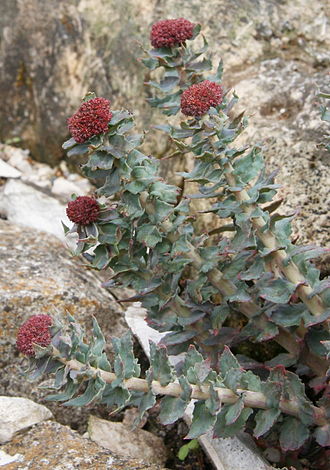Rhodiola

Rhodiola is a genus of perennial plants in the family Crassulaceae[1] that resemble Sedum and other members of the family. Like sedums, Rhodiola species are often called stonecrops. Some authors merge Rhodiola into Sedum.[2][3]
Rhodiola species grow in high-altitude and other cold regions of the Northern Hemisphere.[4] Den virtuella floran gives the number of species as 36,[5] the Angiosperm Phylogeny Website gives it as 90,[1] and the Flora of China gives it as about 90, with 55 in China and 16 endemic there.[4] Flora of North America lists only three species in the United States and Canada.[6]
Among the distinguishing characters of the genus are two series of stamens totaling twice the number of petals; free or nearly free petals (not joined in a tube); a stout rhizome from whose axils the flowering stems rise; and a basal rosette of leaves. This genus contains the only species of Crassulaceae that have unisexual flowers.[4][7]
Rhodionin is a herbacetin rhamnoside found in Rhodiola species.[8]
Although Linnaeus distinguished Rhodiola from Sedum on the basis of being dioecious,[9] it was later submerged in the latter genus until the twentieth century, when it was restored, on the basis of well developed rhizomes and annual flowering stems, arising from axils of the scaly radical leaves. This separation was subsequently confirmed by molecular phylogenetic studies. [10]
Rhodiola is placed within family Crassulaceae, in subfamily Sempervivoideae, tribe Umbiliceae. There it is a sister group to Pseudosedum,[11] though some authors have suggested that the latter genus be submersed within Rhodiola.[10]
